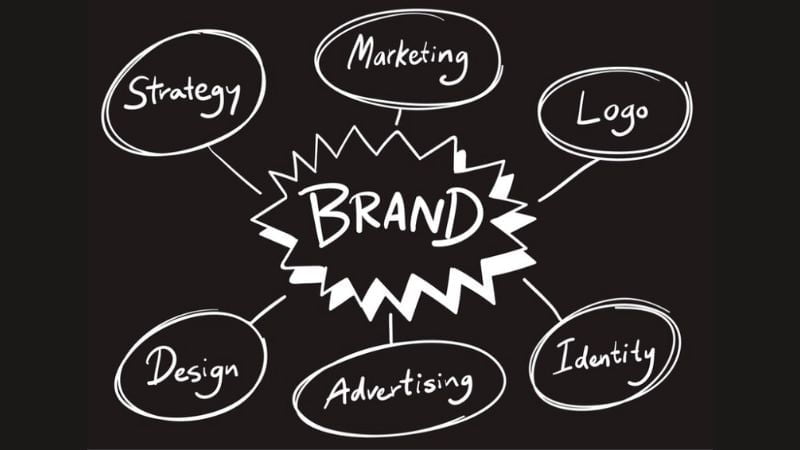Do you know what this term means? Branding is an important idea in marketing. But it can be confusing, even for those working in marketing. This article explains branding simply using easy words and examples.
To grasp the concept of branding, it’s essential first to learn about the meanings of products and brands.
Product vs. Brand
A product is a real object or a service developed and sold to meet customers needs. It’s what we buy, sell, or trade in business and marketing. Products can be things we can touch, like items or ideas, or a mix of different things.

A brand is like a special symbol, name, or design that people recognize. It also includes the feelings and experiences it gives to people. It is a powerful tool for identifying and differentiating one product, service, or company from another.
For example, you can see that there are many coffeeshops in a city. They all sell similar types of coffee beans and make coffee in almost the same way. The coffee itself is a simple product – just a drink made from coffee beans and water.
But, why do different coffee shops get people to choose their coffee instead of others? The answer is in branding. It’s like creating a unique and recognizable identity that makes people want one brand of coffee over another.
What Is Branding?
Definition
Branding is all about creating a recognizable identity for a product, service, company, or organization. Its goal is to establish a unique image in customers’ minds through elements such as logos, names, symbols, and more. In this way, branding leaves a distinct impression on potential customers.
When a product or service is branded effectively, it develops its own personality and story. Branding extends beyond merely labeling something; it involves identifying what makes the product special, empathizing with those key qualities, and providing people with numerous reasons to care about it.
Strong branding enables consumers to understand what a product does and why it’s worth their attention. It can tap into their emotions and influence their decision-making process. Therefore, branding is not solely about recognition and identification; it’s about crafting a compelling image that offers real value. The most successful brands shape how people perceive and connect with products and companies.
Impact of Branding
The power of branding is not only for choosing products. It’s like a friendly guide for customers, explaining why your brand is unique and better than others. Through building emotions and trust, it forms a strong connection, making customers feel comfortable. The main goal is to make shopping enjoyable, especially buying your products.
For those invested in the company, such as investors and employees, effective branding makes the company more attractive and reliable. It draws in funds, talented individuals, and partners. A positive brand reputation showcases the company’s strength and fills everyone with pride to be a part of it. As a result, they’re encouraged to develop the brand and the company.
Elements of Branding
Brand Identity: You can think of it as a brand’s appearance, like its name, logo, colors, and other visual things that make it easily recognizable. It’s like the brand’s face.
Brand Messaging: This is how the brand communicates with its customers. It includes things like slogans, the way it tells stories and sends key messages to customers. It’s what makes the brand interesting and outstanding.
Brand Personality: Imagine the brand as a person and define how it communicates and interacts with its audience, giving the brand a distinct character. For example, a brand might be described as friendly, sophisticated, or adventurous. It depends on the product and field of operation of the business.
Brand Positioning: It’s like finding the perfect place for the brand in people’s minds and the market. Where does it fit among other choices? Figuring this out is super important.
Brand Values: These are the brand’s core beliefs and what it stands for. If the brand is true to these values, it becomes strong and reliable.
Brand Experience: This is the whole journey of interacting with the brand, from seeing it online to talking to customer service. When everything feels connected, it’s a great experience.

Furthermore, it’s imperative to craft a well-thought-out brand communication strategy to breathe life into the brand and offer diverse audiences an immersive experience. This entails aligning the brand with every facet of the organization to maintain its coherence and fortitude. This implementation phase of branding frequently intersects with various marketing strategies. Here are some concrete examples:
Web Design and Online Presence: A visually appealing and user-friendly website serves as a digital gateway for customers to interact with your brand.
Advertising and Communication Campaigns: These encompass a wide array of channels, including newsletters, social media advertisements, television commercials, radio spots, magazine placements, and outdoor advertisements. They all play pivotal roles in shaping the brand’s narrative.
Product and Packaging Design: The design of your products and packaging can make a significant impact on consumers’ perceptions, helping to differentiate your brand from competitors.
In-Store Experience: For brick-and-mortar businesses, the physical store environment, layout, and ambiance contribute to the overall brand experience.
Sponsoring and Partnerships: Collaborations and sponsorships with like-minded organizations or events can further strengthen the brand’s identity and reach a broader audience.
Customer Service: Every interaction a customer has with your brand’s representatives leaves an impression. Exceptional customer service can reinforce positive brand associations.
Workspace Experience and Management Style: Internally, how your organization operates, its management style, and the work environment should reflect the brand’s values and identity, aligning with the external image.
By carefully organizing these elements and ensuring their harmony with the brand, you can create a holistic and engaging brand experience that resonates with your target audience.
Conclusion
In simple terms, a product represents what you offer for sale, a brand encapsulates the perception formed around that product, and branding encompasses the deliberate approach to shape that perception.